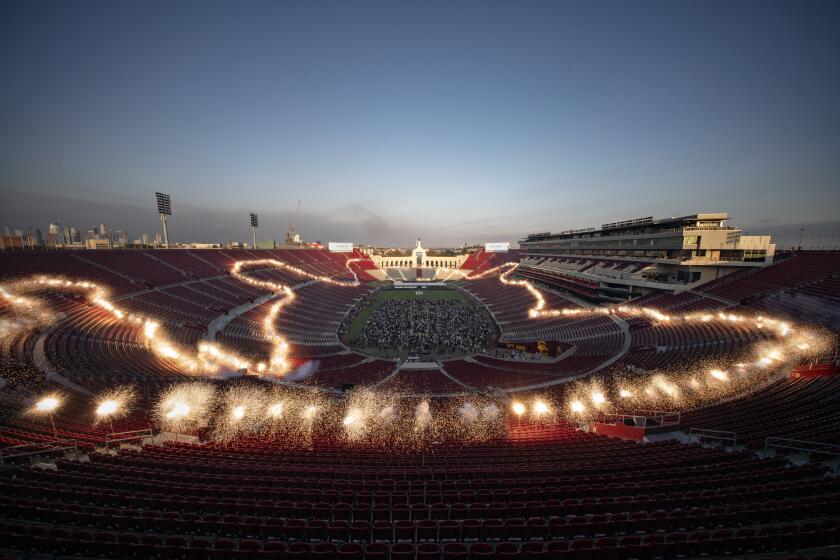Despite Cuts, Curtain Soon to Rise on High School Arts Conservatory
The founders envisioned “Fame” with a difference.
The South Bay Center for the Arts Conservatory would be a school setting where talented young people could seek advanced training in the performing and visual arts.
But while the movie “Fame” focused on an actual building--the former High School for Performing Arts in New York City--this program would be more far-flung.
The new conservatory, opening Sept. 10, will be based at El Camino College. Its students, however, will still study at their home high schools, traveling to the El Camino campus for advanced training at least three times a week. As of Thursday, 223 students from six South Bay school districts had enrolled in classes in the visual arts, dance, music and theater.
The concept is unusual. The logistics are complex. And now, on the eve of the conservatory’s opening, planners face a new problem.
State budget cuts have endangered three facets of the program: transportation, staff development and special “pre-conservatory” classes at six high schools.
Most plans remain intact. But recent state cuts have cost the program about $70,000 of its $522,000 budget for the 1990-91 academic year. And El Camino administrators, already frenetically preparing for the opening, are now forced to grapple with the cuts as well.
One immediate problem is transportation. Rented vans were to transport students whose parents could not drive them to the El Camino campus, in an unincorporated area north of Torrance and west of Gardena. Now, school officials are studying alternatives.
Conservatory Principal Burt H. Peachy carried a transportation questionnaire Wednesday as he helped students register in a campus recital hall. He politely asked several parents to fill out the forms, in hopes of piecing together an impromptu car-pooling system.
While administrators scrambled to preserve parts of the program, students eagerly talked about their hopes for the year ahead.
Flutist Charmaine Moore, 16, a Leuzinger High School senior from Hawthorne, wants to learn more about music theory and technique at El Camino. She talked about the prospect with fervor.
“I really love to play my instrument. I never bore myself,” she said, grinning. “I’ll be watching TV, and I’ll feel like playing, and so I’ll go and play an hour or two.”
Moore doesn’t play pop; she prefers classical, particularly Bach and Corelli. Some day, after El Camino, she said, “I’d like to be a flutist in the orchestra. Maybe a solo flutist?”
Another conservatory student, Melissa McCloud, 15, an Inglewood High School junior, plans to concentrate first on dance at El Camino and then study acting and voice.
McCloud is enrolling because, she says, “I don’t want to pass up a chance.” She races on: “And I really want an agent. I really want an acting career--commercials and movies. I also want to sing in the movies.”
She shrugs, laughing at herself. “I love them all.”
It is for students like these that officials and teachers from El Camino and the six area school districts spent more than a year planning the conservatory. Last September, 143 people consumed a whole day discussing the idea.
“I came back saying, ‘This is never going to work. They’re never going to agree on anything,’ ” said Philip Westin, El Camino dean of fine arts and executive director of the South Bay Center for the Arts, the existing campus arts program.
But as the talks continued, traditional barriers tumbled.
“It’s the first time I’ve seen high school and college faculty sit down and take responsibility for training the same student,” Peachy said.
The funding for the first year includes a $300,000 grant from the state Department of Education, as well as services provided by El Camino and the local districts.
El Camino officials traveled to other arts high schools in California and elsewhere. They visited the “Fame” high school’s successor, LaGuardia High School of Music and Art and the Performing Arts, next to Lincoln Center in New York City.
They chose not to adopt all of the “Fame” precepts. For example, LaGuardia is a magnet school that draws students from across New York City to take a range of courses, including math and English, Peachy said. The South Bay conservatory students, in contrast, will continue taking both arts and non-arts classes at their home high schools.
Another LaGuardia technique--the grueling audition--was also rejected.
“We were very, very concerned about auditions being exclusionary,” Peachy said. Some students are well versed in how to audition, while others get rattled by the process, even though they might be equally talented, he and Westin said.
So the conservatory relies on the local high schools to recommend students.
Those who enroll will take classes at El Camino at no cost at least two afternoons a week and on Saturdays. Concurrently, they will take arts classes at their home high schools.
The program encompasses four semesters and two summer sessions. Students will earn a minimum of a year’s worth of college arts credits.
Students will have free access to selected performances at the campus-based South Bay Center for the Arts. And they will participate in the college’s artist-in-residence program, which consists of special classes with visiting artists.
Local high school arts teachers were reassured to learn that students would continue in their classes.
“That was a very big topic,” said Carol Verhoef, a drama teacher at Mira Costa High School in Manhattan Beach who served on the steering committee. “We thought these kids would just desert us, and we wouldn’t have anyone for our shows.” Now, she said, “I’m even hoping my students will bring back some new ideas for us.”
Tempering the enthusiasm for the new program is concern that the budget cuts will prevent some students from attending.
The $70,000 in cuts are primarily a result of Gov. George Deukmejian’s recent veto of $480 million in education funds from the new state budget.
The cuts include $43,000 targeted for eight “pre-conservatory classes” at six high schools that do not have classes in some arts disciplines.
“That’s the one that’s going to hurt us the most,” Westin predicted.
Miraleste High School in Rancho Palos Verdes, for instance, does not offer classes in dance or drama. So the conservatory plan included an instructor for entry-level dance and drama classes at Miraleste.
“It would be the farm club for advanced programs to be held at the college,” said Miraleste Principal Andrew Seymour.
Now, those classes may not materialize. At least two Miraleste students will not be able to attend the conservatory, since students must enroll in arts courses at El Camino and their home schools at the same time, Seymour said.
“It’s a disappointment for us, in that we would have liked to have provided as many performing arts opportunities as possible,” Seymour said.
The cuts could affect another plan--that of bringing together arts teachers from around the area for four all-day sessions a year. The meetings would carry on the tradition that led to the conservatory’s founding and help plan the next year’s curriculum.
“That’s been seriously undermined,” Peachy said, because the school districts would not have the money to pay for substitutes for the teachers.
“When we saw the clouds gather in early July, I began writing to foundations,” Peachy added. “Unfortunately, I have to report back, we’re getting a lot of ‘nos.’ ”
Some money may still be forthcoming, possibly from local corporations, administrators say.
Despite these fiscal problems, educators say they are confident the conservatory is getting off to a strong start. They are enthusiastic about the quality of the students and faculty.
“We see it as being just a tremendous opportunity,” said William J. Watkins, El Segundo High School principal. “The advantage is availability . . . to get people involved in the arts together in one spot, rather than some kids going one place and some going someplace else.
“To get that all going in one location is a great asset.”
More to Read
The biggest entertainment stories
Get our big stories about Hollywood, film, television, music, arts, culture and more right in your inbox as soon as they publish.
You may occasionally receive promotional content from the Los Angeles Times.










